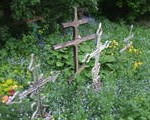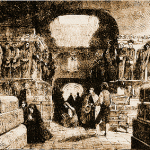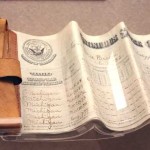Genealogy Records 101
Searching Cemeteries – Genealogy Tip
September 7, 2008 by Chris
Filed under Articles, Cemetery Searches, Genealogy Cemetery Searches, Genealogy Records 101
 Here is a s quick genealogy tip for searching cemeteries. Sometimes the obvious isn’t all that apparent. Remember that in past centuries, almost all people were buried according to ethnic origin or religious affiliation.
Here is a s quick genealogy tip for searching cemeteries. Sometimes the obvious isn’t all that apparent. Remember that in past centuries, almost all people were buried according to ethnic origin or religious affiliation.
So, the tip is: don’t waste your time looking in a Presbyterian cemetery for a Catholic ancestor. Sounds obvious now that I’ve said it, but it is such an easy (and frustrating) mistake to make.
Take care.
…
Where to Next?
…
Social Security Death Records
February 18, 2008 by Chris
Filed under Genealogy Death records, Genealogy Records 101, Public Records
 Another great article by Leo Talbot:
Another great article by Leo Talbot:
The Social Security Death Index (SSDI) contains the names and vital information of around 65 million deceased Americans. It is an extremely large and important database for genealogy enthusiasts. Information is archived in the SSDI when a death has been reported to the Social Security Administration (SSA), such as when a family member stops the Social Security Benefits (SSB) of a person, or applies for survivor’s benefits.
In the early 1960’s, the SSA began using computer technology to store vital records. Therefore, most records included in the SSDI have death dates of 1962 or later, and birth dates from the early 1900’s. Although there are a few birth dates as far back as the 1850’s, and death dates prior to 1960, not all earlier data has been entered into the current SSDI.
Social Security Death Records
Social Security Death Records (SSDR) usually contain the following data on a deceased individual:
- Last name
- First name
- Date of Birth
- Date of Death
- Where the last SSB was sent
- State of residence
- Where the SSN was issued
- Last known address
SSDI Search Tip #1: Use maiden names when searching for women. SSDI is a valuable genealogy tool. The SSDI can assist your genealogy research by providing data that will help you locate birth certificates and death certificates. By providing the names of parents, a female’s maiden name, people’s places of residence and their occupation, it may also assist in the search for marriage certificates and other vital records.
SSDI Search Tip #2 : Start your search on the SSDI with just a few facts. You can search on any combination of data. A last name and known possible birth period may be a good place to start. If the results are too large, add additional data and search again. Also, do not use middle initials – middle names are not recorded in the SSDI.
Soundex Search is a very useful feature that can assist where names may have been misspelled.
Leo Talbot writes genealogy articles such as the social security death index and others
(A Genealogy Beginner Sponsor)
Free Death Records at Ancestry.com
February 10, 2008 by Chris
Filed under Genealogy Death records, Genealogy Records 101, Public Records
 Today Ancestry.com announced a suite of new free death records databases including:
Today Ancestry.com announced a suite of new free death records databases including:
- 1641-1819 Emigrants to Pennsylvania
- 1750-1886 Burials at St. Mary’s Church, Gateshead, Durham, England
- 1844-1884 Missouri State Census Collection
This is in addition to the following databases updated in the past 10 days:
- Beaver County, Pennsylvania Families
- Every name Index to Egle’s Notes and Queries Chiefly Relating to Interior of Pennsylvania
- Early Pennsylvania Land Records
- Early Friends and Families of Upper Bucks
- Colonial & Revolutionary Families of Pennsylvania, Volume III
- Colonial & Revolutionary Families of Pennsylvania, Volume II
- 1903 Edition of the Complete American Armoury and Blue Book
- 1907 Edition of the Complete American Armoury and Blue Book
- The History of Haverhill [Massachusetts]
The folks at Ancestry.com seem to keep at it around the clock, providing us with abundant resources. If you haven’t visited recently, it is worth viewing this amazing site for free death records and other vital genealogy information.
…
Where to Next?
Blank Family Tree with Step-by-Step Instructions
…
Searching Cemetery Monument Foundations
February 9, 2008 by Chris
Filed under Articles, Cemetery Searches, Genealogy Cemetery Searches, Genealogy Records 101
 This book will intrigue anyone involved in serious genealogical research, posing a whole new way to uncover family roots and facts through research into cemeteries and their contents. This book has all kinds of great information from funeral art to conducting cemetery surveys. The author, Sharon Debartolo Carmack, covers how to access and interpret death certificates, obituaries, coroner’s records, wills, memorial and prayer cards, funeral home records, and mortality schedules. She also outlines the process of locating individual graves and elusive cemteries.
This book will intrigue anyone involved in serious genealogical research, posing a whole new way to uncover family roots and facts through research into cemeteries and their contents. This book has all kinds of great information from funeral art to conducting cemetery surveys. The author, Sharon Debartolo Carmack, covers how to access and interpret death certificates, obituaries, coroner’s records, wills, memorial and prayer cards, funeral home records, and mortality schedules. She also outlines the process of locating individual graves and elusive cemteries.
You can read more about this guide on Amazon.com:
Your Guide to Cemetery Research
…
Where to Next?
…
Voter Registration List Reveals Celebrity Genealogy
February 2, 2008 by Chris
Filed under Genealogy Civil Records, Genealogy Records 101, Getting Started
 PROVO, Utah, Jan 31, 2008 /PRNewswire via COMTEX/ — Ancestry.com, the largest online resource for family history, today announced the launch of California Voter Registration Lists documenting more than 30 million names of Californians who registered to vote between 1900 and 1944. Several California celebrities and political figures are found inside the collection, including: Actor and future U.S. President Ronald Reagan was registered to vote in 1942 as a Democrat and remained a registered party member until atleast 1954. According to Reagan’s 1958 voter registration, he and wife Nancy Reagan changed their party affiliation to Republican.
PROVO, Utah, Jan 31, 2008 /PRNewswire via COMTEX/ — Ancestry.com, the largest online resource for family history, today announced the launch of California Voter Registration Lists documenting more than 30 million names of Californians who registered to vote between 1900 and 1944. Several California celebrities and political figures are found inside the collection, including: Actor and future U.S. President Ronald Reagan was registered to vote in 1942 as a Democrat and remained a registered party member until atleast 1954. According to Reagan’s 1958 voter registration, he and wife Nancy Reagan changed their party affiliation to Republican.
- Lucille Ball is found in the collection registered as a Communist in 1936 and 1938, and was later asked to testify before Congress during McCarthy’s Communist witch hunts.
- According to the 1944 records, Ozzy and Harriett Nelson are both registered as Republicans. Harriett was employed as an “actress,” and Ozzy as an “orchestra leader.”
- In a 1924 voter registration list, Walt Disney is found alongside brothers Robert and Roy. Walt and Robert were registered as Republicans, while Roy chose to “decline statement.” In 1940, Walt’s wife Lillian changed her party affiliation to Democrat, while Walt remained Republican.
“These records give evidence of a changing and growing America,” said Smolenyak. “Every American with California roots can appreciate this collection and what it tells them about how their own family evolved over the years.”
…
Where to Next?
Blank Family Tree with Step-by-Step Instructions
…
Dachau Concentration Camp Records
January 31, 2008 by Chris
Filed under Genealogy Military Records, Genealogy Records 101, Public Records
 The Dachau Concentration Camp Records are a chilling yet important tool for those searching for relatives who may have been impacted by the world wars.Dachua was the first concentration camp established, and registered over 200,000 prisoners over its history.
The Dachau Concentration Camp Records are a chilling yet important tool for those searching for relatives who may have been impacted by the world wars.Dachua was the first concentration camp established, and registered over 200,000 prisoners over its history.
The data contained in these records may include:
- Family name
- Given name
- Date of birth
- Place of birth
- Last place of residence
- Street or provincial location
- Prisoner number
- Category of prisoner
- Date of arrival in Dachau
- Ultimate fate of prisoner in Dachau
Read more about Dachau Concentration Camp Records
Search Dachau Concentration Camp Records
Stephen Morse has a great website with numerous genealogy search references and information. I strongly recommend a visit.
…
Where to Next?
Blank Family Tree with Step-by-Step Instructions
…
US Department of Veterans Affairs
January 28, 2008 by Chris
Filed under Genealogy Military Records, Genealogy Records 101, Public Records
 Wondering if the VA has any records you can use to obtain the military history of a friend or relative? The short answer is no. The U. S. Department of Veterans Affairs does not maintain such as military units assigned to, dates and places of assignment, pay records, etc. For information about military records, visit the National Archives Records Administration website at http://www.archives.gov/.
Wondering if the VA has any records you can use to obtain the military history of a friend or relative? The short answer is no. The U. S. Department of Veterans Affairs does not maintain such as military units assigned to, dates and places of assignment, pay records, etc. For information about military records, visit the National Archives Records Administration website at http://www.archives.gov/.
I’ll post about The National Archives shortly; they have some interesting news today about increases in budgets.
…
Where to Next?
Blank Family Tree with Step-by-Step Instructions
…
